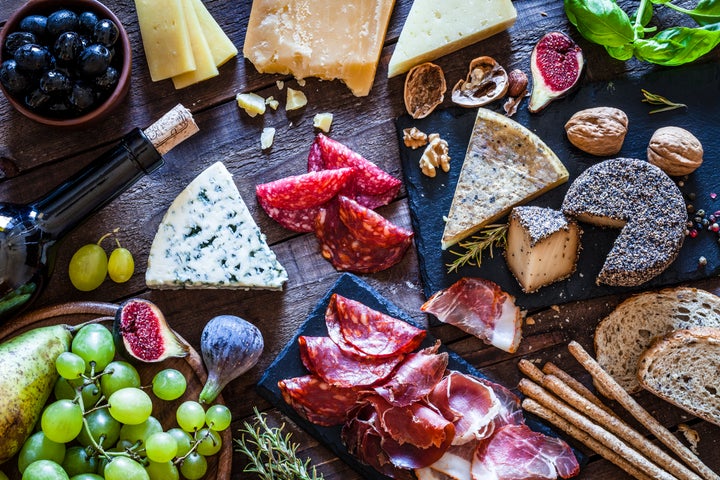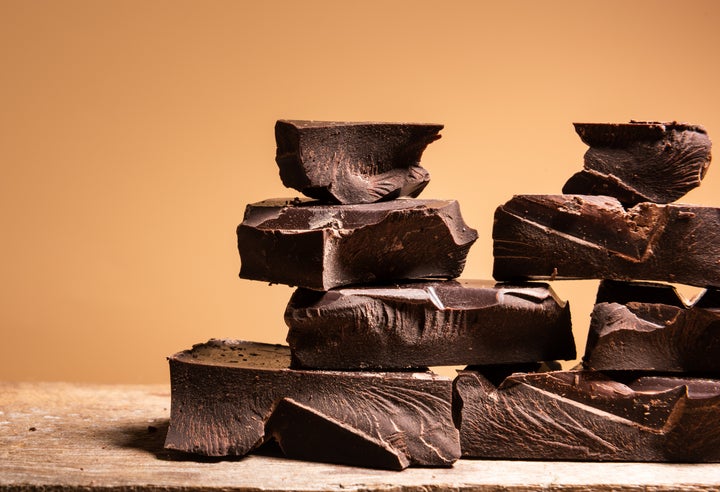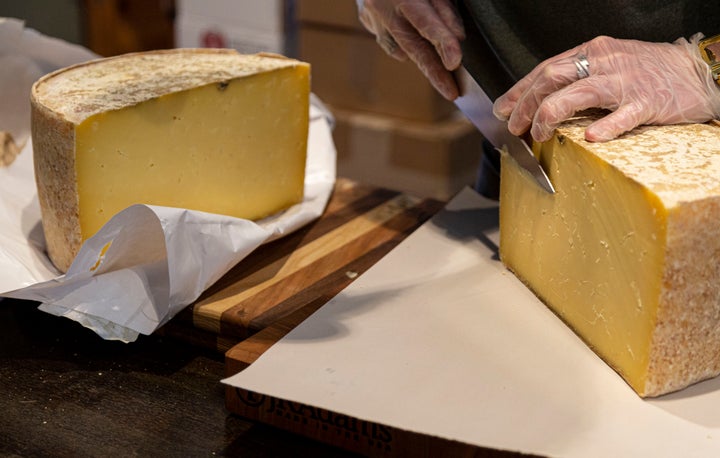
Migraines are the worst. If you don’t get them, think of them like a hangover without the party before. Sounds are louder, smells more pungent and lights extra bright. There’s also nausea, dizziness and, obviously, a killer headache.
While neurologists are still debating the exact causes of migraines, certain foods and drinks are known to trigger an attack in many. For me, blue cheese and white wine can bring them on, while my brother can’t eat anything with artificial sweeteners. Unlike most lists of foods to avoid, migraine triggers aren’t necessarily unhealthy if you don’t have the condition.
Getting A Migraine Isn’t Your Fault
There’s a lot of stigma around migraines; people who experience them are often dismissed as having “just a headache.” But let’s be clear: Migraine is a neurobiological disease caused by a genetic predisposition. Folks with migraine didn’t do anything to make themselves ill.
“[While] some foods are somewhat more likely to trigger an attack, it is important to state that no one ever should feel responsible for their migraine attack,” explained Dr. Thomas Berk, a neurologist, headache specialist and medical director of New York-based Neura Health. “You didn’t do anything to cause your migraine.”
People experiencing migraines have a hyperexcitable and reactive nervous system, according to Berk, which means that a series of stressors or triggers can bring on an attack. While there are some common ones, like certain types of foods and changes in hormone levels, everyone’s triggers are unique.
“A migraine trigger refers to any external or internal factor that contributes to the onset of migraine symptoms,” said Dr. Danielle Wilhour, a neurologist and migraine specialist at UCHealth Neurosciences Center in Aurora, Colorado. “Combining multiple factors is probably a more potent influence.”
Because migraine is a complex disorder, simply avoiding certain foods won’t be the key to preventing an attack.
“While dietary changes can be helpful, a more holistic approach that focuses on healthy lifestyle and a balanced diet is crucial,” Wilhour explained. “In some cases, medical interventions may be necessary for effective migraine management.”
Despite the complexity of migraines, knowing which foods and beverages are common triggers can help inform and prevent future attacks. With that in mind, here are the five most common migraine-triggering foods and beverages.
1. Alcohol
We all know that too many glasses of wine with dinner or too many after-work cocktails can give anyone a nasty headache, but for folks with migraine, as little as a single glass can cause an attack. Why? The reason isn’t clear, according to Wilhour.
“While alcohol itself, as well as its metabolites, are potential factors in some instances, it’s also plausible that certain components in various alcoholic beverages may serve as triggers,” she said. “Alcohol is known to cause vasodilation, causing blood vessels to swell.”
Adult beverages can be dehydrating, which may also cause an attack. Some folks find that they can enjoy certain types of hard liquor but can’t drink wine, or vice versa.
If you’re partial to a glass of vino, you should know that red wine is more often linked to an immediate attack, due to the naturally occurring compound tyramine. Tyramine is found in a few other migraine triggers as well, including dark chocolate and aged cheese.
“Migraine attacks have also been speculated to be associated with the presence of some biogenic amines (histamine, tyramine, phenylethylamine, etc.) which could theoretically trigger a headache,” said Dr. Teshamae Monteith, an associate professor of clinical neurology and the chief of the headache division at the University of Miami Miller School of Medicine.
2. Chocolate

Skip the box of chocolates for your migraine-affected Valentine! Chocolate is considered the most popular food-based trigger. However, neurologists are debating whether craving bonbons before an attack is part of the prodome (or pre-attack phase of a migraine) or a trigger.
Whichever it is, one potential reason could be the cocoa.
“Cocoa is thought to influence serotonin release, possibly contributing to migraine pathogenesis,” Wilhour explained. “Although chocolate contains serotonin and its precursor tryptophan, with higher levels in 85% cocoa content, existing studies haven’t confirmed a direct link to migraine induction.”
3. Caffeine (Too Much Or Too Little)
When I first got diagnosed with migraines, my neurologist recommended that I down a shot of espresso at the onset of an attack to help stop it. As a teenager with infrequent access to Italian coffee shops, that didn’t quite work for me. But caffeine is sometimes used to treat migraines, even in certain over-the-counter medications.
Too much caffeine can also bring on a migraine. “Caffeine acts by impacting a molecule called adenosine by blocking its receptor,” Monteith explained. “It can reduce brain electrical activity, widen blood vessels and alter sleep. Naturally, adenosine levels increase during acute migraine attacks but can also be trigged by adenosine infusions.”
Like alcohol, caffeine has a dehydrating effect, which can trigger a migraine. For healthy adults, the Food and Drug Administration recommends consuming no more than 400 milligrams in a day, or four to five cups of coffee. For managing migraines, you may want to drink less, according to Berk.
“Regulating caffeine can be helpful as it is a vasoconstrictor and can be used to acutely treat a migraine attack,” Berk said. “Typically we recommend that patients with migraine limit caffeine to a cup of coffee (or caffeinated tea) at the same time each day (preferably before noon to ensure good sleep).”
Since regular consumption of coffee, tea or even your favorite energy drink can create dependence, skipping your afternoon cup of joe can also cause an attack.
3. Aged Cheese

Some aged cheese contains tyramine, which is developed as the cheese ferments. This means that the older (and smellier) the cheese is, the more tyramine it has.
“It is believed that elevated levels of tyramine can trigger migraines in susceptible people,” Wilhour said. “Tyramine is known to affect blood pressure and may influence the release of neurotransmitters like norepinephrine, which can be involved with migraines.”
Common offenders include aged cheddar, manchego, and blue cheeses like Gorgonzola and Stilton. (It turns out that many cheeses are aged, so do a little research before your next trip to the grocery store.)
4. Cured And Processed Meats
Breakfast favourites like bacon and sausage, as well as “girl dinner” staples like salami and prosciutto, might be worth skipping, as these can contain nitrates and nitrites.
“Nitrates can be converted into nitric oxide, which is a signalling molecule that plays a role in the regulation of blood flow,” Wilhour said. “Changes in blood flow are associated with migraines, and nitric oxide production may contribute to these changes. Additionally, nitrates may activate the trigeminal nerve (a nerve which is involved in the migraine pain pathway) and cause inflammatory neuropeptide release.”
Blame it on the gut microbiome: A 2016 study found that people with migraines may have higher levels of the bacteria that help break down nitrates. More bacteria mean more nitric oxide, which has a demonstrated association with migraines. Researchers hope to one day create a probiotic mouthwash that can re-balance bacteria levels.
5. Fasting (Not A Food, I Know)
While not a food or beverage, the experts I spoke with noted that skipping a meal is one of the most common migraine triggers. A 2018 study reported that “fasting is among the best studied and most reliable natural migraine triggers and becomes more common with longer fasts.”
When we miss a meal or two, our blood sugar drops. For some folks, even small changes in glucose levels can interfere with pain receptors in the brain’s lining. (There are no pain receptors in the brain itself.) To stave off migraines, keep protein-packed snacks on hand if you know you will be running late.
And if you forgot your emotional support water tumbler at home, that can also lead to a migraine. When the body dehydrates, fluid leaves the brain, causing friction in the meninges and potential pain.